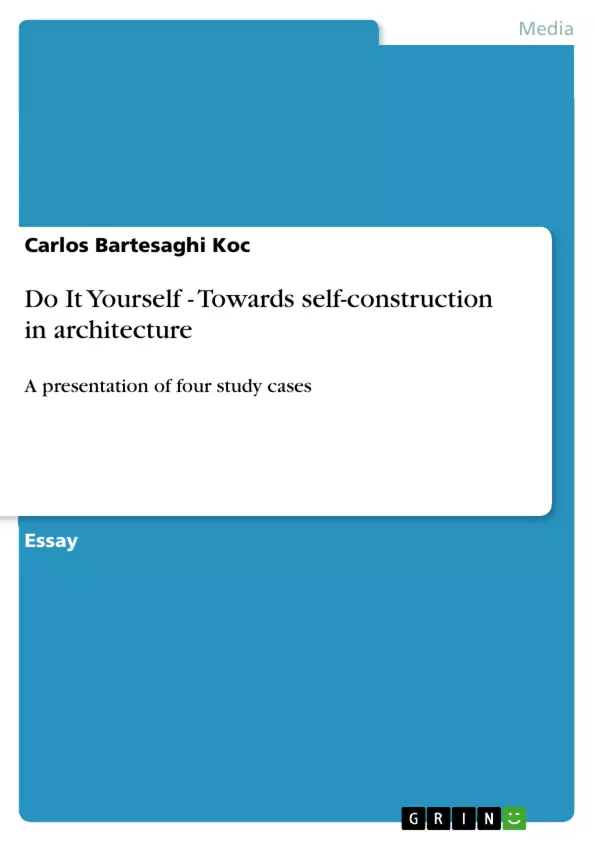Many people believe that architecture is used inappropriately to obtain fame, richness and prestige with a disregard for societies’ welfare, and that it is not capable to contribute socially and environmentally to humanity.
In this context, this essay focuses on presenting the ‘Do it Yourself Design Approach’ as an initiative to establish self construction processes to adapt high-technologies in communities affected by distressed conditions.
Four architecture and urban projects undertook during the last four years exemplify how this vision could be achieved to improve the quality of life in both the city and rural areas.
Designers have the opportunity to draw a balanced future for all acting as mediators in community involvement. Through this essay, I call everybody to expand their action beyond paper, beyond the studio; benefitting wealthy and poor communities alike, in order to reduce the social, economic and cultural gaps of our societies.
Inhaltsverzeichnis (Table of Contents)
- Introduction
- Revalorizing the empirical
- The eco-cylinder, a shelter from waste
- The systemic eco-touristic community
- The self-manufactured shelter
- The quarry as a place to be
- Conclusions
Zielsetzung und Themenschwerpunkte (Objectives and Key Themes)
This essay explores the potential of "Do It Yourself Design" (DIYD) as a sustainable and equitable approach to architecture, particularly in contexts characterized by resource scarcity and social inequities. The essay examines the limitations of high-tech solutions and emphasizes the importance of rediscovering and adapting traditional knowledge and practices to create solutions that are locally relevant and culturally sensitive.
- The limitations of technology-driven approaches to sustainable development in diverse contexts
- The significance of revalorizing empirical knowledge and traditional practices in architecture and design
- The potential of DIYD to address social inequities and promote self-sufficiency in communities
- The importance of integrating local resources and cultural values in architectural design
- The application of DIYD principles in various contexts, illustrated through case studies
Zusammenfassung der Kapitel (Chapter Summaries)
- Introduction: This chapter explores the limitations of high-technology solutions in addressing global issues, particularly social inequities. It introduces the concept of Do It Yourself Design (DIYD) as an alternative approach that emphasizes local knowledge, resourcefulness, and self-sufficiency.
- Revalorizing the empirical: This chapter highlights the value of traditional knowledge and practices in architecture and design. It examines examples from the Peruvian Highlands and African communities where indigenous practices have proven to be more effective and sustainable than imported technologies.
- The eco-cylinder, a shelter from waste: This chapter presents a specific case study of a DIYD project, focusing on the construction of an eco-friendly shelter using readily available materials and techniques. It showcases the potential of DIYD to provide affordable and sustainable housing solutions.
- The systemic eco-touristic community: This chapter explores another case study of a DIYD project, focusing on the development of a sustainable and self-sufficient eco-tourism community. It emphasizes the integration of local resources, cultural values, and community participation in the design process.
- The self-manufactured shelter: This chapter presents a case study of a DIYD project that involves the design and construction of a shelter using locally sourced materials and techniques. It showcases the adaptability and ingenuity of DIYD in providing housing solutions in resource-constrained environments.
- The quarry as a place to be: This chapter presents another case study of a DIYD project, focusing on the transformation of a quarry into a functional and aesthetically pleasing public space. It highlights the potential of DIYD to revitalize neglected urban spaces and create spaces that are both functional and culturally relevant.
Schlüsselwörter (Keywords)
This essay focuses on key concepts such as Do It Yourself Design (DIYD), sustainable development, social equity, local knowledge, traditional practices, indigenous architecture, resourcefulness, self-sufficiency, and community empowerment. It examines the potential of DIYD as a framework for addressing global challenges through locally-driven solutions.
- Quote paper
- B.Arch (First Class) Carlos Bartesaghi Koc (Author), 2011, Do It Yourself - Towards self-construction in architecture, Munich, GRIN Verlag, https://www.grin.com/document/176417



